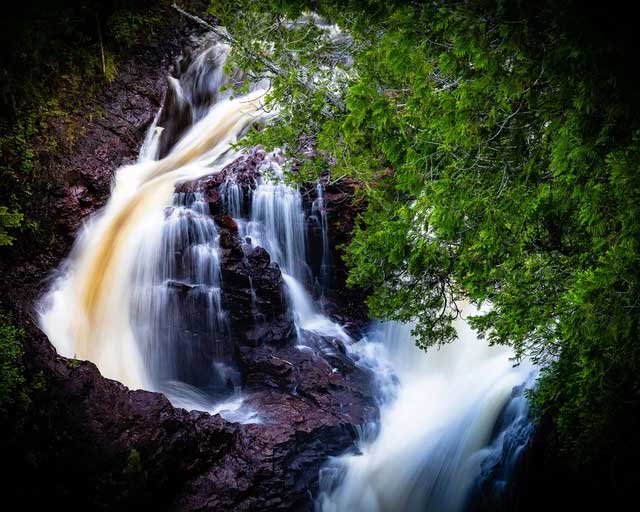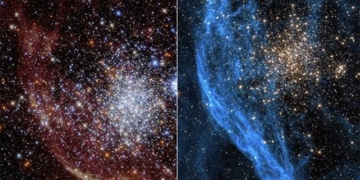The Devil’s Kettle waterfall, located in Minnesota, USA, has a flow that enters Lake Superior; however, the destination of the other flow remains a mystery of nature…
The Devil’s Kettle Waterfall has puzzled geologists and explorers for decades.
Along the northern shore of Lake Superior, the Brule River, situated a few miles south of the US-Canada border, is split in two by a rock outcrop in the middle. While one flow cascades down the rocky ledges into Lake Superior below like other ordinary waterfalls, the other side flows into a deep hole known as Devil’s Kettle and disappears right there. To this day, where this smaller waterfall leads remains an intriguing question.

The Devil’s Kettle Waterfall.
Believing that there must be an endpoint for this flow somewhere beneath Lake Superior, many researchers and adventurers have poured dye, ping pong balls, and logs into the Devil’s Kettle hole, waiting for signs at the lake’s surface. However, as of now, everything put into this deep hole has vanished.
This phenomenon becomes even more mysterious and strange when geologists come to examine the Devil’s Kettle.
If in movies, beneath this deep hole lies a vast and long underground river, in reality, such deep underground caverns are extremely rare and usually form in areas with softer rocks like limestone. Meanwhile, the geology in northern Minnesota is composed of much harder types of rock.
For some of the harder rocks in the area, such as Rhyolite and Basalt, theoretically, their tectonic processes might impact the underlying rock layers, creating an environment where water can seep through. However, there is no evidence that such phenomena have occurred in the geological strata of the region. And if such a phenomenon truly existed, the Devil’s Kettle would not be able to draw water from the Brule River infinitely.

All items thrown into this deep hole have disappeared.
Another hypothesis suggests that millions of years ago, a hollow lava tube formed beneath the basalt layer at the falls. Over time, water flowing in eroded the Rhyolite rock surface and flowed straight down into this lava hole, creating a large opening beneath the bottom of Lake Superior. However, this hypothesis raises many questions. In reality, lava tubes form in basalt that flows down volcanoes; and if the geology in northern Minnesota could create an exception to that theory, no lava tubes have ever been discovered in the hundreds of basalt layers in the area.
In 2017, hydrologists from the Minnesota Department of Natural Resources (DNR) claimed to have solved the mystery using a simple method: measuring the water flow above and below the waterfall. They discovered that the water levels were almost identical at both points, indicating that the water that disappears into the hole returns to the river from underground just after the waterfall.
So where did all the objects thrown down go? Researchers explain the absence of floating objects returning to the surface due to the strong currents in the plunge pool of the falls, which are powerful enough to keep most materials submerged until they are ground down.
To confirm their findings, they planned to conduct a dye tracing study in the fall of 2017 by pouring biodegradable fluorescent dye into the hole and watching where it appeared again in the river. However, the park management discouraged them from doing so, and they reluctantly determined that the dye experiment was scientifically unnecessary to confirm the reconnection of water to the river below the falls.

The branch of the Brule River flowing into Devil’s Kettle returns to the river from underground just after the waterfall.
However, many remain skeptical of the DNR’s explanation. Some argue that measuring water flow is insufficient to prove where the water goes because there may be other water sources contributing to the downstream river. Others point out that there are still many unanswered questions about the geology and hydrology of the area, such as how deep and wide the hole is, what type of rock lies beneath, and how water moves through them.
The Devil’s Kettle waterfall remains a source of wonder and curiosity for many who visit Judge C. R. Magney State Park. It is also a beautiful and picturesque location to enjoy nature and marvel at its mysteries. If you want to witness it firsthand, you can hike along the 2-mile (3.2 km) round trip trail following the Brule River from the river’s mouth to the branch at the waterfall.


















































